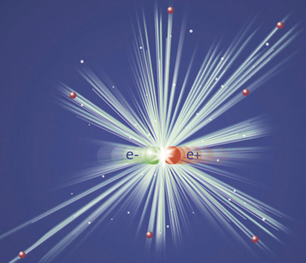The next machine to look deeper into the atom
an interview with physicist Marc C. Ross
The magnets of the largest machine in the world, the Large Hadron Collider, were energized on the morning of
September 10, 2008. It fired its first beam of protons around an acceleration tunnel 17 miles in circumference,
beneath the nations of France and Switzerland. Several technical delays occurred after that, but they were
resolved and the first particle collisions were achieved in November of 2009. The enormous machine is reaching
its design performance and petabytes of data are being generated from its operation. Every design has its
tradeoffs and limitations however, and there’s undoubtedly more inside the atom than this machine will be
able to reveal.
The next-generation project that’s planned is the International Linear Collider. It will collide atomic
particles in a different way, have higher resolution imagers, and bring us closer than ever imagined to
understanding the full nature of matter in our universe. Physicist Marc C. Ross is involved in the ILC project
and has worked with both the theoretical and practical aspects of linear colliders since the ‘80s. He was our
communications contact for this article and shed some light on a topic that’s sometimes
very hard to understand.
Q. The ILC (International Linear Collider) is in a planning stage. What lessons have you learned, or hope to learn,
from the Tevatron and Large Hadron Colliders?
A. The ILC is in a planning stage – but the technology and the design is ready to go! It has been under development
since the early 1990’s, for almost 20 years. A key practical lesson has been: How can we better prepare for a
project of this magnitude. And the biggest part of that is to make sure that all the high-tech aspects are
thoroughly tested and understood. On the scientific side, the practical aspects of the analysis of the particles
produced by the collider, and duly recorded by the big detectors, has been a key lesson. These groups – especially
the tried-and-true group at the Tevatron – have learned how to divine more and more of the details of the
collisions without a major re-vamping of their equipment. Of course, that only goes so far, and the aim of the
ILC, which uses electrons and positrons rather than protons (or anti-protons) is to provide a substantial boost to
these studies through the intrinsic precision of ‘point-like’ projectiles. Protons (and anti-protons) have a
composite nature that blurs or weakens their collisions.
Q. If you didn’t have to compromise for the sake of cost and practicality, what design features would be at the
top of your wish list?
A. Cost and practicality are so embedded in our everyday thinking that it is very hard to answer your second
question. As a taxpayer – are you not pleased that is so? After all, the media sometimes report projects where this
kind of mentality was momentarily forgotten – with telling result. Perhaps the real answer to your question is to
think about the way we like to develop and build devices such as the ILC and LHC. The labs and groups who take it
upon themselves to develop or pioneer a new technology are usually faced with many ‘which comes first: Chicken
or Egg?’ questions. I am amazed at how interested your readers – and the general public – are when they learn
how nature works and the different ways we have to get those answers. If I had a ‘wish list’… To truly capture
the imagination of the public would be on the top, definitely. Armed with the appreciation and understanding of
the public at large, we would have more young students entering the field, more general discussion in the
community, and greater sense of purpose and direction – especially for applications of high technology, (among
other things).
Q. The Tevatron and LHC both use circular raceways for particle acceleration but the ILC will use a linear
raceway. What’s the reason for the design difference?

Matter meets antimatter. If an electron and a positron collide at at high speed in the TESLA accelerator,
both are annihilated - i.e. they are converted into pure energy, out of which new elementary particles can
arise. (Source: DESY Hamburg, Germany)
A. The difference – circular vs. linear – is inherent in the kind of particle used for the collision. In other
words, to get the precision that comes with point-like particles, such as electrons, we have to overcome the
effects directly attributable to their ‘lightness’ or low mass. Light particles release energy through the
emission of light – ‘radiation’ while traversing a curved trajectory. The release of course results in a kind
of ‘slowing down’ of the particle. For high energy machines like ILC, this effect is enormous and cannot be
overcome – so we have to go ‘straight’ in order to use electrons and positrons. Protons are only mildly affected
by this problem – but there is another, quite difficult ,challenge for them. The heaviness of the proton is such
that one is required to use very strong magnets to bend their trajectories – when the protons are at high energy.
With the LHC, we may be reaching the natural limits of such electromagnets, making it very hard to keep on
increasing their energy without building even larger rings. It hardly seems the proper way to go.
Q. The atom was considered to be the quantum particle of matter until about 1897 when physicist J. J. Thomson
discovered the subatomic electron. Then the neutron and proton particles were discovered after that. Currently
the Standard Model suggests many smaller subatomic particles. Do you expect we’ll continue to find smaller and
smaller constituent particles as our instrument capabilities increase?
A. It is hard to say we expect to see ‘smaller’ particles, at this point. As far as we know, the electron and
its companion particles are really ‘point-like’. However, our ability to see smaller and smaller sizes is
directly related to the strength of the tool we use. It is tempting to use the analogy of a microscope. A more
powerful microscope uses stronger fields and more energetic radiation. So it is with our accelerators and the
particles we try to observe. The composite nature of protons makes it harder to see ‘smaller’ particles directly
with a machine like LHC – but ILC is different, and that kind of study would be easier with it.

Q. When you think of atoms as groups of subatomic particles – mostly empty space - being held in place by
electromagnetic and nuclear forces it seems like it should be a little wiggly, like when one magnet suspends
another. Yet, for the most part, matter appears to have a solid, stable permanence. Can you explain how atoms
maintain this structural integrity?
A. This question – on the stiffness of matter – is an important one! You are quite correct – the structural
integrity of matter does not evoke a lattice of little magnets. And there is a key part missing if one thinks
only of electromagnetic and nuclear forces. It is this, I believe: the electrons – which define the volume of
an atom – are ‘fermions’ not ‘bosons’, so each one fills a specific space, a specific piece of the volume
surrounding the heavy, attractive, nucleus, which fundamentally cannot be shared by another. Why they behave
like this, really, is still a mystery – at least to me. This ‘non-sharing’ makes an atom’s volume a pretty well
defined space. Whereas lots of science fiction ideas could come true – the idea of two bits of matter passing
through each other and remain intact – cannot happen, largely because of this effect.
Q. The Higgs boson is the prize catch right now in quantum physics because it’s a missing piece in the
Standard Model puzzle. Its importance is sometimes difficult to explain, but could it be thought of simply as
the particle that causes energy to "condense" into matter?
A. The point-like particles that seem to comprise the matter around us have a curious range of masses or weights.
The Higgs particle is the key piece of a model which gives each one of these more ‘basic particles’ its weight.
This is done, according to the model, through the strength of the coupling between the Higgs boson and a given
particle, for example an electron. A simple analogy to this coupling is the popularity of a celebrity. With
greater popularity, journalists and admirers are attracted more strongly and more of them gather around, making
it harder for the celebrity to move around (or to go anywhere!). A popular ‘celebrity’ has more ‘mass’, in this
analogy. Yes. The coupling to the Higgs boson causes mass.
Q. Some scientists have speculated that the LHC or ILC could actually reveal evidence of ‘other dimensions’.
Could you describe a possible scenario of this?
A. I don’t know how to answer the question about extra dimensions. Suffice it to say --- that the precision
measurements the ILC will make may allow the development of theories and models that better explain how all
these basic, fundamental particles are related.
Q. If the Large Hadron Collider is successful in the discovery of the Higgs particle, what would be the primary
mission of the ILC?
A. This is the one of my dream scenarios. The ILC is designed – in part – for this scenario. It’s mission would
be to map the detailed connections between the Higgs and related particles. The ILC could do, with precision,
what the LHC can only hint of. If there was a long time lag between the discovery at the LHC and the construction
of the ILC, I am sure that the LHC scientists would be able, in part, to overcome the blurry-ness due to the
composite nature of the proton and would be able to refine their studies – but the ILC does a much better job,
intrinsically.
Q. I imagine a dynamic and sometimes chaotic environment in which physicists are constantly proposing new
theories and experiments they’d like to try. Is this the case, and is it difficult to refine these things into
a coherent project?
A. It is easy to imagine a dynamic and chaotic working environment where exotic creativity can be sensed in
everything anyone says. Reality is more subdued, of course, especially when one actually begins to build
something. The very foundation (?) of accelerators is the earth and concrete they sit in. These are not fluid –
quite the opposite. Working with tunnel boring machines and large infrastructure keeps us sane and well grounded.
At the beginning, as always, there is an extraordinary exchange of ideas – which boils down to the question:
Can technology provide most important answers? At a reasonable cost and schedule? Once everybody answers ‘YES’,
then the real work begins.
Q. Are there any current estimates on a construction schedule?
A. It is reasonable to assume the ILC would take at least 7 years to build. Because it is an international
project, some time would be required, up-front, to devise the needed arrangements between countries. This is
more than simple politics: it is attractive to believe that science transcends many of the boundaries we have
in our world.
Q. Do you have any discovery predictions for the next five or ten years
A. I hope for the best from LHC. And, for many in this field, results from satellites and telescopes will be a
central focus of their work. These scientific devices are complementary to ground-based accelerator experiments.
I expect ‘dark matter’ and related studies will make substantial progress. After all, study of that particular
sub-topic is just getting started. □

Physicist Marc C. Ross is an Accelerators Directorate member at Fermilab, and co-Project Manager for the
International Linear Collider Global Design Effort.
